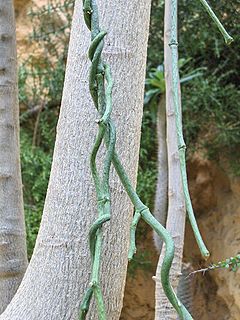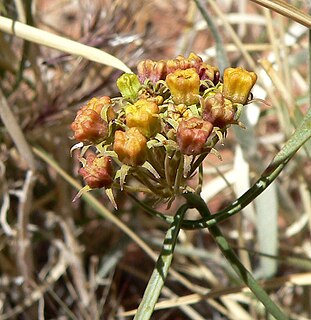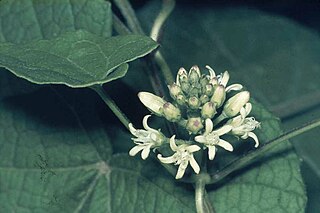
According to APG II, the Asclepiadaceae, commonly known as milkweed family, is a former plant family now treated as a subfamily in the Apocynaceae.

Asclepias is a genus of herbaceous, perennial, flowering plants known as milkweeds, named for their latex, a milky substance containing cardiac glycosides termed cardenolides, exuded where cells are damaged. Most species are toxic to humans and many other species, primarily due to the presence of cardenolides, although, as with many such plants, there are species that feed upon them and from them. The genus contains over 200 species distributed broadly across Africa, North America, and South America. It previously belonged to the family Asclepiadaceae, which is now classified as the subfamily Asclepiadoideae of the dogbane family, Apocynaceae.
Celandine ( or is a common name for three species of flowers:

Chelidonium majus, the greater celandine, is a perennial herbaceous flowering plant in the poppy family Papaveraceae. One of two species in the genus Chelidonium, it is native to Europe and western Asia and introduced widely in North America.

Cynanchum is a genus of about 300 species including some swallowworts, belonging to the family Apocynaceae. The taxon name comes from Greek kynos and anchein, hence the common name for several species is dog-strangling vine. Most species are non-succulent climbers or twiners. There is some evidence of toxicity.
Pilewort is a common name for plants that were traditionally used to treat piles.(hemorrhoids) This herb was more commonly used throughout the Tudor period in England. Pilewort may refer to

Vincetoxicum rossicum is a flowering plant in the family Apocynaceae. It is a perennial herb native to southern Europe and is a highly invasive plant growing in all of the Eastern United States, in the mid west, and southern Ontario and Quebec in Canada. It has several common names including swallowwort, pale swallowwort, and dog-strangling vine. There has historically been much confusion about the genus it belongs to, with authors placing it within Vincetoxicum and others within Cynanchum, but recent molecular and chemical analyses have shown it to belong in the genus Vincetoxicum.

Vincetoxicum is a genus of plants in the family Apocynaceae. Although the species in Vincetoxicum have sometimes been included in Cynanchum, chemical and molecular evidence shows that Vincetoxicum is more closely related to Tylophora.

Cynanchum utahense is a species of flowering plant in the genus Cynanchum of the family Apocynaceae, known by the common names Utah swallow-wort and Utah vine milkweed. This relatively uncommon perennial vine is native to the Mojave Desert from California, Nevada, Utah and Arizona in the United States. This is a small vine with a highly branched, twining stem rarely exceeding a meter in length with which it physically supports itself on other shrubs and trees. It has small narrow leaves a few centimeters long. Its flowers are bright yellow to orange and grow in umbels. The fruit is a grooved follicle several centimeters long.

Vincetoxicum hirundinaria, commonly named white swallow-wort, is a long-lived herbaceous perennial of the genus Vincetoxicum in the family Apocynaceae.

Vincetoxicum nigrum, a species in the family Apocynaceae, also known as black swallow-wort, Louise's swallow-wort, or black dog-strangling vine, is a species of plant that is native to Europe and is found primarily in Italy, France, Portugal, and Spain. It is an invasive plant species in the northeastern United States, parts of the Midwest, southeastern Canada, and California. New Zealand, Timaru, 2020, wild plants found.

Cynanchum laeve is a vining perennial herb native to eastern and central U.S. states and Ontario. Common names include sand vine, honeyvine, honeyvine milkweed, bluevine milkweed, climbing milkweed, and smooth swallow-wort. The root system of C. laeve can cause it to be very difficult to eradicate, especially in agricultural fields. It is a larval food of monarch butterflies and milkweed tussock moth larvae. C. laeve can cause eye irritation if touched and can be toxic to humans and livestock if consumed in large quantities.
Climbing fig is a common name for several plants in the genus Ficus and may refer to:

Cynanchum viminale is a leafless succulent plant in the family Apocynaceae. The species is native to West Africa, the Indian Ocean and Western Pacific region. The species' natural range extends from South Africa throughout much of Africa and the Middle East to India, Indochina, Southern China, Indomalaya and into Meganesia. The species is also found on several Indian Oceans islands including Mauritius, Réunion and the Seychelles.
Cynanchum auriculatum is a species of climbing vine swallowworts. Its Chinese name is niu pi xiao [ 牛皮消 ]. C auriculatum flowers between June and August; fruiting from August all the way to December.
Wild hops is a common name for several plants

Cynanchum ellipticum is a South African climbing plant of the family Apocynaceae, with slender stems and branches, exuding milky, bitter latex that is non-irritant. It occurs in coastal scrub from Cape Town as far north as Mozambique and further inland up to 1300 m, and may be found on flats or moderate slopes, in sand or between rocks, in indigenous forests and along forest margins and thickets, frequently occurring in disturbed habitats.











